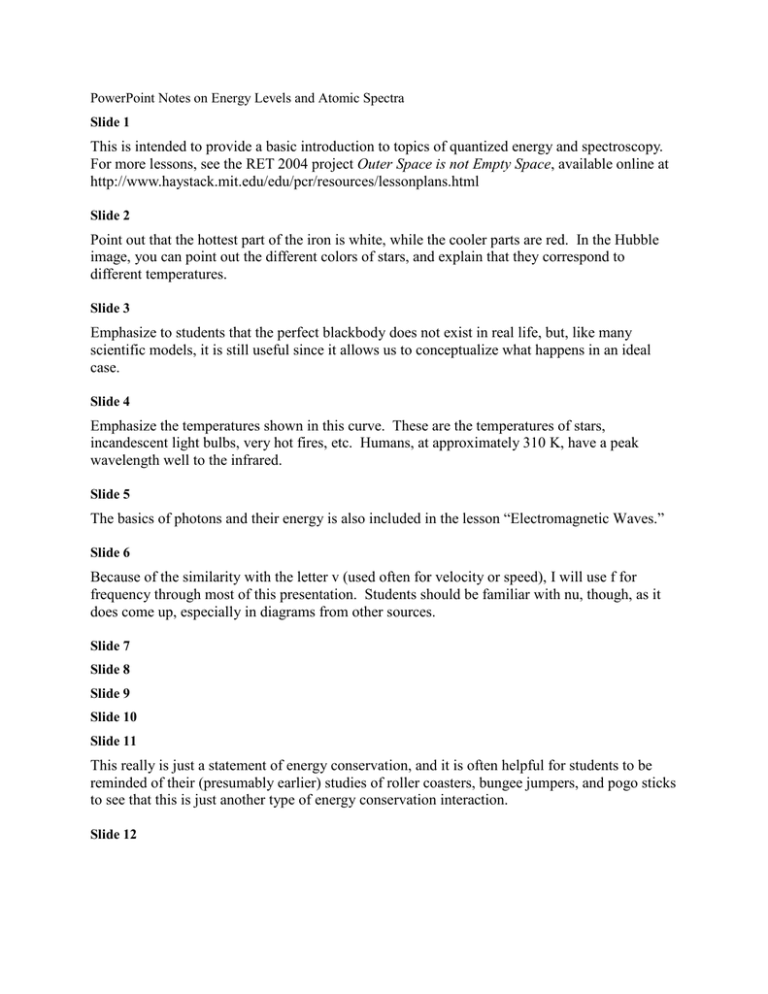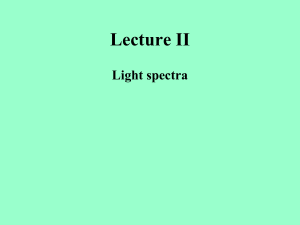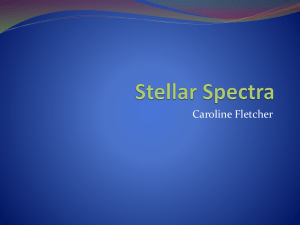This is intended to provide a basic introduction to topics... Outer Space is not Empty Space
advertisement

PowerPoint Notes on Energy Levels and Atomic Spectra Slide 1 This is intended to provide a basic introduction to topics of quantized energy and spectroscopy. For more lessons, see the RET 2004 project Outer Space is not Empty Space, available online at http://www.haystack.mit.edu/edu/pcr/resources/lessonplans.html Slide 2 Point out that the hottest part of the iron is white, while the cooler parts are red. In the Hubble image, you can point out the different colors of stars, and explain that they correspond to different temperatures. Slide 3 Emphasize to students that the perfect blackbody does not exist in real life, but, like many scientific models, it is still useful since it allows us to conceptualize what happens in an ideal case. Slide 4 Emphasize the temperatures shown in this curve. These are the temperatures of stars, incandescent light bulbs, very hot fires, etc. Humans, at approximately 310 K, have a peak wavelength well to the infrared. Slide 5 The basics of photons and their energy is also included in the lesson “Electromagnetic Waves.” Slide 6 Because of the similarity with the letter v (used often for velocity or speed), I will use f for frequency through most of this presentation. Students should be familiar with nu, though, as it does come up, especially in diagrams from other sources. Slide 7 Slide 8 Slide 9 Slide 10 Slide 11 This really is just a statement of energy conservation, and it is often helpful for students to be reminded of their (presumably earlier) studies of roller coasters, bungee jumpers, and pogo sticks to see that this is just another type of energy conservation interaction. Slide 12 Slide 13 Because the Balmer series happens to be in the visible part of the spectrum (and therefore in the part of the spectrum that our atmosphere is transparent to), Balmer lines are very important for astronomers. There is lots of hydrogen in the universe, and when Balmer lines are present, they come through the atmosphere and can be observed from Earth. They are often referred to as Halpha, H-beta, H-gamma, and so on, with H-alpha corresponding to the longest wavelength Balmer line (656 nm), H-beta corresponding to the next (486 nm), etc. Slide 14 If students have already studied rotational energy and angular momentum, this would be a good opportunity to remind them that there is energy associated with different types of rotations, and changing from one rotational mode to another corresponds to a change in energy state. Slide 15 Slide 16 For more information on dispersion, see the “Optics Basics” lesson. Slide 17 From here on, this PowerPoint consists of a number of slides useful for teachers and students studying the details of spectra and spectral analysis. Astronomy students may be interested in it, and teachers may find it useful for students interested in self-study. Physics classes wishing to go into some depth on the practicalities of spectra may also find its contents useful. Slide 18 Slide 19 Ask students to explain how a solid or dense gas will act approximately like a blackbody and will therefore produce a nearly continuous spectrum. A rarefied gas will emit only the wavelengths corresponding to transitions of the atoms in the gas. A cool gas will absorb the wavelengths corresponding the transitions of the atoms in the gas, leaving behind “dark lines” in the continuous spectrum. Stars produce absorption spectra, since the core of the star acts like a blackbody, but the cooler gas in the outer atmosphere of the star absorbs certain wavelengths. Slide 20 Slide 21 The graph on the left shows a stellar absorption spectra for one star. Point out to students that the x-axis is in wavelength, and, instead of visual spectrum with the colors, a graph has been made with intensity on the y-axis. On the right, there is a supernova remnant, which has energy on the x-axis (which could be converted to wavelengths if necessary). Students may notice that the intensity graphs are not always level. This is because of the blackbody spectrum of the object upon which the absorption or emission lines are superimposed. Ask students the question in the text box. In stars, light is formed in the stellar core and passes through a less dense layer of stellar atmosphere, producing absorption lines. The SNR, however, is much less dense, and emits only the light corresponding to the atoms within the SNR. Slide 22 These are shown as emission spectra, but you could remind students that they could just as easily see these as absorption spectra, with the continuum present and only the wavelengths corresponding to the element missing. http://www.colorado.edu/physics/2000/applets/a2.html links to an applet showing the electron structure and accompanying spectrum for the first 36 elements. Slide 23 The solar spectrum is probably the most well studied spectrum in science. From it, we can conclude almost everything we are interested in about the sun, including composition, density, magnetic field, etc. Helium was discovered (and got its name) through the solar spectrum, and only later was concluded to be the same element as the noble gas on Earth. Slide 24 In very hot stars, there is too much energy available to individual atoms to remain bonded to each other. Instead, each atom becomes independent. Slide 25 Slide 26 Hot stars have nearly all their hydrogen ionized and thus it does not emit Balmer lines. Cool stars do not provide enough energy to get the electrons in hydrogen into the n=2 energy state, from which the Balmer lines are formed. Slide 27 Slide 28 The Doppler effect is also discussed in the lesson “Wave Properties.” Slide 29 Slide 30 Slide 31 This is very similar to the discussion of pressure broadening in the “Wave Properties” lesson. Slide 32 Slide 33 Slide 34 Point out to students the differences in the labeling on the y-axis for these two graphs. The dotted line in each case corresponds to the contribution to the spectrum from the ozone in the lower atmosphere. Slide 35 Slide 36 This is an image of a sunspot. On the right, students should be able to see that the spectral line has split into two or possibly three parts due to the slight changes in energy due to electron spin in the presence on a magnetic field.




